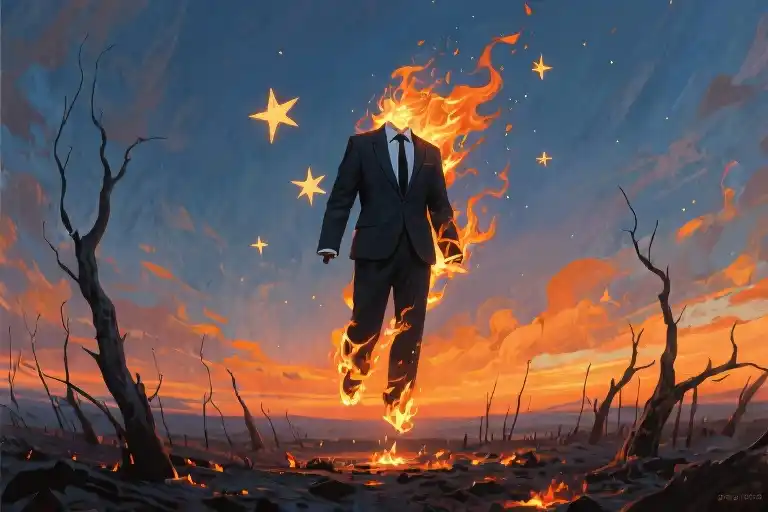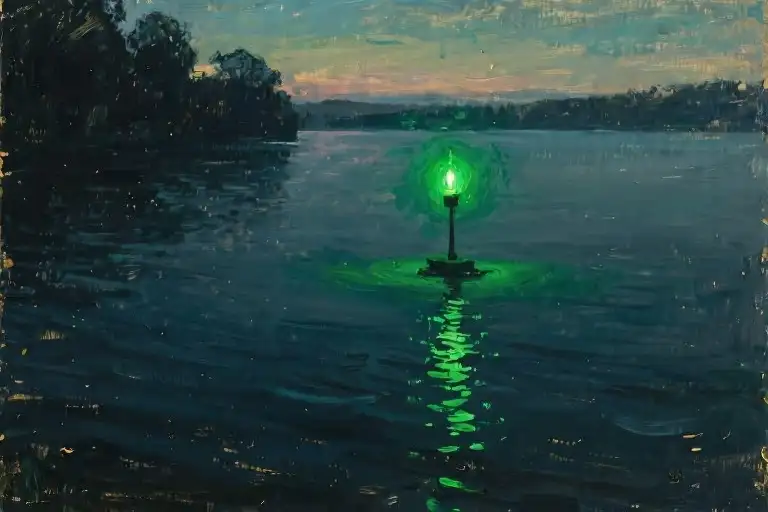The air tastes like charcoal and regret. I stand at the edge of what used to be common sense, watching the flames lick at the foundations of everything we pretended to value. The heat warps the faces of the crowd—not in horror, but in something closer to ecstasy. Their smartphones capture the glow while their mouths shape the same silent scream: we voted for this. Not the wildfires, not the crumbling infrastructure, but the slow, deliberate unraveling of collective dignity. The fire department watches from a safe distance, polishing their badges with white gloves.
This isn’t a metaphor. Or rather, it stopped being one when hospitals started charging for ashes. When school boards banned water while the children burned. The American identity crisis manifests in real time—not as debate but as performance art, with politicians tossing Molotov cocktails labeled ‘tradition’ and pundits selling scented candles made from the Constitution. The scent? Nostalgia and napalm.
My passport blisters in my back pocket. Born here by accident, raised here by default, I’ve spent adulthood collecting exit strategies like some people collect vintage lunchboxes. When border agents ask my nationality, I say ‘New York’ the way others might say ‘unaffiliated.’ The word American fits me like a thrift-store tuxedo—stiff in the shoulders, stained with someone else’s history, reeking of cheap whiskey and cheaper promises. We’re all dressed for a funeral no one will admit is happening.
Through the smoke, I see them: the well-documented undoing. Stockbrokers using burning bills to light cigars. Protesters and counter-protesters roasting marshmallows on the same flaming cross. A toddler in a ‘Future President’ onesie chewing on a piece of shrapnel. Political disillusionment has never been so literal. The founding fathers’ wigs catch fire one by one, each curl dissolving into that famous American exceptionalism—the kind that mistakes arson for ambition.
The gloves come off. Or rather, they transform. Those same pearl-buttoned accessories that once held teacups at segregated garden parties now tap angrily at touchscreens, leaving digital fingerprints on every lynching video. Progress isn’t linear; it’s a drunken square dance where partners change but the callers remain the same. Allemande left with your systemic racism, do-si-do your reproductive rights away.
Somewhere beneath the soot, my grandmother’s ghost adjusts her hatpin. She remembers when oppression wore kid leather and called itself manners. Now it streams in 4K. The museum of our shame has a gift shop—white hoods in children’s sizes, ‘I ♥ Colonialism’ bumper stickers, miniature statues of liberty with nooses for torches. They accept all major credit cards.
I cough into my sleeve. The fabric smells like grief and gasoline. This isn’t anger anymore; it’s the quiet horror of realizing the house has been burning for generations, and we’ve been calling the glow ‘sunrise.’ The suits in Washington adjust their ties as the country ticks toward another elegant disaster. They’ll send thoughts. They’ll send prayers. They’ll send invoices.
A hot wind carries the sound of glass breaking—maybe windows, maybe promises. Either way, the shards glitter beautifully as they fall. We’ll sweep them up later. Or more likely, we’ll vote to declare them patriotic confetti. The fire spreads. The applause continues. And the tailor stands ready with his measuring tape, whispering that the emperor’s new clothes will be ready any day now.
The Burning Spectacle
The air tastes like charred promises. At the political rally, flames lick the edges of the podium as the speaker’s words ignite another round of applause. Hundreds of phones rise in unison, their screens reflecting the fire like digital votive candles. This is how democracy burns now—with influencer captions and live-streamed destruction.
Three scenes unfold simultaneously in this American crematorium:
1. The Arsonist’s Applause
A senator’s tie catches fire mid-speech about ‘traditional values.’ The crowd cheers louder as the silk burns—blue turning black, stripes curling into ash. Someone shouts “Freedom!” while filming vertical video. The heat warps my vision: for a moment, the flames spell out MIDTERMS in cursive.
2. Healthcare at the Pyre
Outside the clinic, an old man fans the flames of his burning insurance statements with a Medicare card. His oxygen tank sits perilously close to the blaze. “They told me to be patient,” he coughs out between claps, “so I’m waiting right here.” The embers float upward, joining the constellation of other incinerated safety nets.
3. Fitting Room at the Border
The measuring tape snaps against brown skin as agents determine the ‘proper fit’ of American identity. A child stands on the dotted line, arms outstretched like a scarecrow, while the fire behind them melts the border fence into liquid metal. The officers debate sleeve length: “Do we measure to the wrist or where the handcuffs go?”
These aren’t metaphors anymore. The American identity crisis manifests in literal smoke signals—the kind your phone can’t translate. We’ve become a nation of pyromaniac spectators, voting for bigger matches while complaining about the smell of burning wool suits. The political disillusionment tastes like gasoline and Instagram filters.
What fascinates me most isn’t the fire, but what people choose to save from the flames. A woman rescues her designer bag but leaves her voting stub. A man pockets his grandfather’s Confederate coin while his daughter’s college diploma blackens at the edges. We clutch the wrong relics, mistaking nostalgia for heritage.
At the immigration center, the measuring tape keeps snapping. The children learn quickly: to be American is to stand very still while others determine what fits you. The fire spreads. The applause continues. Somewhere, a white glove catches on a fence post, waving like a surrender flag nobody claims.
The Fitting Room of a Nation
Being born American feels like being measured for a suit you never ordered. The tailor arrives uninvited at your birth, his tape measure snaking around your tiny limbs before you can protest. “Standard American sizing,” he murmurs, already stitching the wool that will itch your skin for a lifetime. The jacket sleeves are cut too short for reaching toward progress, the trousers tailored to restrict any sudden movements toward change.
For years, I tried altering this inherited uniform. I snipped at the suffocating necktie of patriotism, only to find the fabric frayed into even more uncomfortable edges. I let out the seams around my shoulders where the weight of historical guilt pressed deepest, but the tailor—that invisible hand of systemic inertia—kept restitching them overnight. The pockets were sewn shut to prevent carrying anything of substance, the lining stuffed with outdated receipts for wars and broken promises.
Travel became my secret tailoring kit. In Parisian arrondissements, I admired how the French wore their identities like perfectly draped linen—wrinkled but intentional. Tokyo’s precision-folded social fabric showed how a nation could wear tradition without choking on it. Each passport stamp left me tugging at my American suit’s collar, realizing how poorly it ventilated compared to the breathable identities around me.
Yet the cruelest mirror hung in every foreign fitting room. However far I wandered, the glass always reflected my passport’s eagle crest glowing faintly beneath trial outfits. No matter how comfortably I wrapped myself in another culture’s silhouette, the fluorescent lighting would eventually reveal that stubborn embroidered label on my skin: Made in USA.
The dressing room’s three-way mirror multiplied my discomfort. One panel showed my grandmother’s face peering through—her 1950s housewife gloves still clutching the measuring tape around my waist. Another reflected future versions of myself, all tugging at the same ill-fitting seams. The central mirror forced me to confront today’s reality: a person sweating through layers of inherited fabric, fingers trembling over the top button of a suit that never felt like home.
Sometimes I catch other Americans adjusting their identical suits in airport lounges. We exchange silent nods of recognition—the shared itch of wool in summer, the collective shrug when another thread snaps. In those moments, I wonder if we’re all just waiting for someone to finally scream what we’re thinking: This uniform is a costume, and none of us chose our roles.
The Archaeology of White Gloves
I found my grandmother’s gloves in a mothball-scented box last winter. Not the pristine ones from her wedding photos, but a pair stained with something dark at the fingertips – the kind of stain that sinks into cotton fibers and becomes part of the fabric’s DNA. She wore these when volunteering at polling stations in 1964, the year they stopped making Black voters count jellybeans in a jar before allowing them to vote. The gloves were meant to keep her hands clean while doing dirty work.
Today, we’ve traded cotton for touchscreens. The same violent gestures now happen through emoji gloves – a raised fist reaction here, a clapping hands GIF there. Our ancestors physically gripped the tools of oppression; we delegate ours to the haptic feedback of smartphones. At least grandma had the decency to ruin her gloves. Our digital ones remain spotless through thousands of symbolic strikes.
Last month, the Museum of Modern Tyranny (a guerrilla art installation that popped up in six cities) displayed white gloves under glass with museum tags that read: “Mid-20th century oppression tools. Worn while: 1) Denying school admission 2) Signing redline maps 3) Patting oneself on the back for minimal progress.” Visitors were invited to try on replicas using augmented reality – the gloves appeared perfectly clean on their phone screens even as virtual blood dripped from their wrists.
This is our inheritance: the illusion of clean hands. We’ve perfected what our ancestors invented – systemic violence that leaves no fingerprints. The gloves have simply become invisible. We type racial slurs with manicured nails. We swipe left on entire demographics while getting spa treatments. We vote away human rights between yoga sessions, then congratulate ourselves on our ‘balanced lifestyles.’
Sometimes I catch my reflection in store windows wearing an imagined version of these gloves – they’re made of LinkedIn endorsements and Instagram activism, woven from the silk threads of performative wokeness. They fit perfectly, which terrifies me more than grandma’s bloodstained pair ever could. At least her stains bore witness. Our contemporary gloves are designed to show nothing at all – the ultimate fashion accessory for an era that prefers plausible deniability to accountability.
In grandmother’s day, they needed physical gloves to separate themselves from their actions. We don’t even need that much – just enough emotional distance to click ‘like’ on revolution between ordering groceries and streaming entertainment. The stains now are all beneath the surface, buried in algorithms and policy fine print where they won’t ruin our aesthetic.
Next to grandma’s glove box, I keep my own relics: screenshot folders of hashtag activism, emails to politicians I never called, protest selfies where my sunglasses cost more than some people’s weekly groceries. These are my white gloves – spotless, stylish, and utterly useless at preventing the blood from seeping through.
The Fitting Room Exit
I found myself in a dimly lit boutique that smelled of starch and desperation. The sign above the door flickered between languages – Tailor pour Tous, Schneiderei der Identitäten, Atelier of Unbelonging. This was the mythical transnational fitting room I’d heard about in expat whispers, where they supposedly crafted identity garments without borders. The Armenian seamstress took my measurements with a tape that converted centimeters to inches mid-stretch. The Japanese pattern-maker frowned at my shoulder slope. ‘Problem here,’ she murmured, ‘too much American tension.’
We spent weeks designing what we called the ‘Post-National Suit’ – linen from Italy, silk lining from Vietnam, buttons carved from Lebanese cedar. But when I tried it on, the mirror showed something grotesque: the sleeves twisted into flag stripes, the collar stiffened into constitutional parchment. The more we altered, the more it resembled the very garment I sought to escape. Our final attempt dissolved at the seams when washed with reality.
Defeated, I returned to my original wool suit – that scratchy, sweat-stained relic of accidental nationality. But now I approached it like a textile anarchist. With Turkish scissors, I removed the constricting shoulder pads. With Mexican thread, I patched the elbow holes using fabric scraps from my travels. The breast pocket now held a square of Kenyan kanga cloth; the inner lining bore handwritten lines from Rumi and Baldwin. This Frankenstein garment fit no better, but at least the discomfort felt authentically mine.
Walking back through the metaphorical fire zone, something crunched underfoot. The ashes had cooled into a brittle crust, and there – amid the carbonized remnants of flags and history books – a green shoot twisted upward. I couldn’t tell if it was morning glory or poison ivy, whether this tender rebellion would climb toward light or simply strangle itself in loops. The crowd nearby had stopped applauding the flames and begun brushing gray flakes from each other’s hair with uncertain hands.
Perhaps identity isn’t about finding a well-tailored suit, but learning to wear the ill-fitting ones with enough alterations to breathe. Maybe citizenship is less a garment than a series of adjustments – letting out seams during expansion, taking in fabric when we shrink. As I finger the mismatched buttons on my reconstructed jacket, I realize the most subversive act might be refusing to dress for someone else’s occasion.
Your turn: When was the last time you felt your identity garment pinch? What would you use to alter it?
When All the Suits Burn
The pyres still smolder, but something has shifted in the ashes. Where there was once only the crackle of flames and the roar of self-destruction, now there’s a new sound—hands slapping at embers clinging to sleeves, fingers brushing soot from collars that never quite fit right. The crowd still moves like a single organism, but its purpose has fractured. Some continue fanning the flames with policy papers and social media posts, while others kneel in the gray powder, sifting through what remains.
I watch a woman peel off her scorched blazer—the one with ‘Proud American’ embroidered on the pocket—and use it to smother a small fire at her feet. Nearby, a teenager picks apart the seams of his varsity jacket, removing the school crest with careful precision. The air smells less of burning and more of sweat, that particular human scent of effort and exhaustion after prolonged rage.
We’re all covered in the same fine powder now. It dusts the shoulders of immigrants and natives alike, settles into the wrinkles of MAGA hats and protest signs. When the wind shifts, we cough into our hands and find black residue on our palms—proof that destruction touches everyone, regardless of how carefully we thought we’d dressed for it.
In the quiet moments between sirens, I hear the question whispered like a secret:
What do we wear when all the suits burn?
Some try stitching together new garments from the scraps—a patchwork of ideologies that chafes at the edges. Others stand half-naked, shivering but relieved to be free of the weight. The boldest walk away from the ashes entirely, their bare backs turned to the smoldering remains of what we called a national identity.
Perhaps this is how we begin: not with a new uniform, but with the collective understanding that no single fabric can contain us all. The measurements were always wrong, the tailoring flawed from the first stitch. What grows from these ashes won’t be another ill-fitting suit, but something we can’t yet name—something that allows for breathing room.
As I shake the soot from my hair, I notice green shoots pushing through cracks in the pavement. They’re fragile things, these first tendrils of whatever comes next. We could trample them underfoot in our rush to build new pyres. Or we could kneel beside them, finally free to grow in whatever direction the light takes us.



